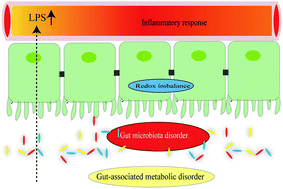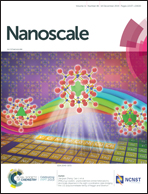Effects of oral exposure to titanium dioxide nanoparticles on gut microbiota and gut-associated metabolism in vivo†
Abstract
The antibacterial activity of titanium dioxide nanoparticles (TiO2 NPs) has been extensively documented and applied to food packaging or environmental protection. Ingestion of TiO2 NPs via dietary and environmental exposure may pose potential health risks by interacting with gut microbiota. We conducted an animal experiment to investigate the effects of oral exposure to TiO2 NPs on gut microbiota and gut-associated metabolism in Sprague-Dawley rats. Rats were administered with TiO2 NPs (29 ± 9 nm) orally at population-related exposure doses (0, 2, 10, 50 mg kg−1) daily for 30 days. Changes in the gut microbiota and feces metabolomics were analyzed through bioinformatics. TiO2 NPs caused significant changes of colon morphology in rats, manifested as pathological inflammatory infiltration and mitochondrial abnormalities. 16S rDNA sequencing analysis showed that the structure and composition of gut microbiota in rats were modulated after exposure to TiO2 NPs. Monitoring data demonstrated that differentially expressed bacterial strains were obtained until exposure for 14 days and 28 days, including increased L. gasseri, Turicibacter, and L. NK4A136_group and decreased Veillonella. Fecal metabolomics analysis showed that 25 metabolites and the aminoacyl-tRNA biosynthesis metabolic pathway have changed significantly in exposed rats. The increased metabolites were represented by N-acetylhistamine, caprolactam, and glycerophosphocholine, and the decreased metabolites were represented by 4-methyl-5-thiazoleethanol, L-histidine, and L-ornithine. Metabolic disorders of gut microbiota and subsequently produced lipopolysaccharides (LPS) led to oxidative stress and an inflammatory response in the intestine, which was considered to be a key and primary indirect pathway for toxicity induced by oral exposure to the TiO2 NPs. In conclusion, orally ingested TiO2 NPs could induce disorders of gut microbiota and gut-associated metabolism in vivo. The indirect pathway of oxidative stress and inflammatory response, probably due to dysbiosis of gut microbiota primarily, played an important role in the mechanisms of toxicity induced by oral exposure to TiO2 NPs. This may be a common mechanism of toxicity caused by oral administration of most nanomaterials, as they usually have potential antimicrobial activity.



 Please wait while we load your content...
Please wait while we load your content...